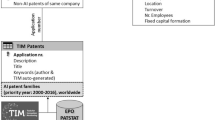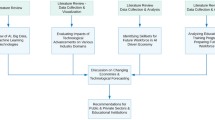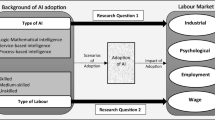Abstract
Many advanced economies have experienced significant job polarization in the last decades, with an increase in the employment share and relative wage of both low-wage and high-wage workers at the expense of middle-wage workers. This polarization has probably been spurred by the substitution of routine-intensive labour with automation and information and communication technologies. This paper explores whether the Italian labour market has experienced similar patterns and, if so, whether they are the consequence of a pure technology-driven shock. The evidence is mixed. While the share of low-wage manual occupations has increased markedly, that of high-wage professional occupations has fallen slightly. The share of middle-wage jobs has declined significantly but, unlike the case of the US, the wages have not. Regression analyses based on occupational task characteristics (Goos et al. in Am Econ Rev 104(8): 2509–2526, 2014) do not fully align with the routine-biased technical change hypothesis either, consistently with the limited adoption of automation technology in Italy. Among the most likely factors, cross-sector reallocation, which favoured the low value added service sector, and the rise of low skilled migrant and college graduate labour supply explain most of the observed occupational changes.









Similar content being viewed by others
Notes
It is important to notice that the analysis is subject to the break in the classification of occupations in 2011 that cannot be fully accounted for. See Sect. 3.2 for a discussion of this issue.
Rosolia (2010) estimates milder growth rates at the tails of the wage distribution than those estimated by Olivieri (2012). The administrative data used by both works do not contain occupational codes: polarization is measured only examining wage percentiles growth and not occupational average wage growth.
Wages are reported in the LFS as gross monthly earnings from labour for employees only and are top-coded at 3000 euros per month. I perform two adjustments: first, I impute hourly earnings for self-employed workers using a simple linear prediction based on observable characteristics (age, foreign-born status, education level, region, part-time status as well as gender, marital status and number of children both separate and interacted). Second, I adjust top-coded earnings by a factor 1.25 following Autor et al. (2009). Results, available upon request, are robust if I do not impute wages to self-employed, if I do not adjust top-coded earnings or if I adjust them by a factor of 1.5.
This is a more coarse classification than that adopted in the US: the Census, American Community Survey, and Current Population Survey contain about 300 three-digit occupations based on the Standard Occupational Classification, or its adaptations.
Starting from the official many-to-many crosswalk between CP2001 and CP2011 occupational codes produced by Istat, the matching procedure uses as weights the 2011 employment of each CP2011 occupation divided by all potential employment if one were using CP2001 codes. Therefore, the solution I adopt to solve for the structural break smooths the series in 2011 around the levels observed between 2007 and 2010 (as I adapt the definition of occupations to the one prevailing before 2011). Although this solution is arbitrary, it creates smooth occupational shares series that are not dramatically affected by statistical artifacts. I am not aware of any other official crosswalk that allows to smooth the occupational series. The crosswalk between the two classifications is available upon request.
Moreover, I also exclude from all the subsequent analyses the flowing two-digit occupation groups: 23 “Teaching professionals”, 33 “Teaching associate professionals”, and 92 “Agricultural, fishery and related labourers”.
Similarly, Goos et al. (2014) rank occupations based on external wage data sources (i.e., panel household survey like the ECHP and the EU-Silc which contains two-digits occupation codes) since the EU LFS do not report wage information at all.
The DOT recorded objective and subjective dimensions of occupational requirements for each six-digit occupation and classified them in 44 variables. The RTI is constructed as the difference in the logarithms of routine cognitive and routine manual minus the logarithms of non-routine analytic, non-routine interactive and non-routine manual scores. Each of these indexes is based on the percentiles values corresponding to their rank in the task intensity distribution (Autor et al. 2003; Autor et al. 2009; Autor and Dorn 2013).
O*NET is the most recent equivalent to DOT. Peri and Sparber’s (2009) measures are interpretable as percentiles, i.e. each occupation is associated with more than one index that characterizes its content of manual and communication tasks relative the use in other occupations. Acemoglu and Autor (2011) also use O*NET to construct task intensity indexes, but their version has only an ordinal interpretation. Acemoglu and Autor (2011) and Autor and Dorn (2013) also use occupational groups rather than task indexes given the arbitrary judgment involved in classifying occupations by aggregating the numerous variables contained in O*NET and DOT..
The only exception is the OECD Programme for the International Assessment of Adult Competencies (PIAAC) that allows constructing task-based index of occupational content for each OECD country (see Arntz et al. 2017, for a recent application). However, PIAAC it has been released very recently and classifying occupations based on recent task specialization may cause endogeneity problems as the task content of occupations evolve exactly because of technological advancements.
The results are robust when measuring employment on hours worked rather than on person counts.
I defer to Sect. 5 a discussion of how recessions and changes in occupational structure could be related.
I need to aggregate industrial sectors into five broad categories. This is because of the changes in the industrial (ATECO) classifications in 2011, which affected mainly service subsectors. Although the service subsectors (professional services, personal services, transportation and communication) are not fully comparable over time, it is worth noting two facts. First, the largest change in the employment share was in the transportation, utilities and ICT (+2.6 between 2007 and 2017 versus +0.3 in professional services and +1.7 in the personal service sector). Second, personal services have among the highest incidence of low-pay occupation (around 60% in 2007), and professional services have the highest incidence in high-pay occupations (64% in 2007). Such large degree of heterogeneity within the service sector is hindered when looking at the aggregated figures.
References
Acemoglu, D., & Autor, D. (2011). Skills, tasks and technologies: Implications for employment and earnings. In O. Ashenfelter & D. Card (Eds.), Handbook of labour economics (Vol. 4B, pp. 1043–1171). Amsterdam: North-Holland.
Adamopoulou, E., Bobbio, E., De Philippis, M. et al. (2016). Wage rigidities and business cycle fluctuations: A linked employer-employee analysis. IZA Journal of Labour Policy. https://doi.org/10.1186/s40173-016-0078-5.
Arntz, M., Gregory, T., & Zierahn, U. (2017). Revisiting the risk of automation. Economics Letters, 159, 157–160.
Autor, D. H., & Dorn, D. (2013). The growth of low-skill service jobs and the polarization of the US labour market. American Economic Review, 103(5), 1553–1597.
Autor, D. H., Katz, L. F., & Kearney, M. S. (2006). The polarization of the U.S. labour market. American Economic Review, 96(2), 189–194.
Autor, D. H., Katz, L. F., & Kearney, M. S. (2008). Trends in U.S. wage inequality: Revising the revisionists. Review of Economics and Statistics, 90(2), 300–323.
Autor, D. H., Levy, F., & Murnane, R. J. (2003). The skill content of recent technological change: An empirical exploration. Quarterly Journal of Economics, 118(4), 1279–1333.
Autor, D., & Salomons, A. (2018). Is automation labour-displacing: Productivity growth, employment, and the labour share. Brookings Papers on Economic Activity (forthcoming).
Ballatore, R., Colonna, F., & Depalo e Santiago Pereda-Fernández, D. (2018). Educational mismatch in Italy: An appraisal. Bank of Italy Occasional Paper (forthcoming).
Bank of Italy. (2018). Annual Report on 2017. Rome, Italy
Bárány, Z. L., & Siegel, C. (2018). Job polarization and structural change. American Economic Journal: Macroeconomics, 10(1), 57–89.
Basso, G., Peri, G., & Rahman, A. (2017). Computerization and immigration: Theory and evidence from the Unites States. NBER Working Paper No. 23935.
Brandolini, A., Gambacorta, R., & Rosolia, A. (2018). Inequality amid income stagnation: Italy over the last quarter of a century. Bank of Italy Occasional Paper No. 442.
Brunetti, I., Cirillo, V., & Ricci, A. (2018). Tecnologia e variazione dell’occupazione nei mercati locali del lavoro. INAPP Working Paper No. 13.
Brynjolfsson, E., & McAfee, A. (2011). Race against the machine. Lexington: Digital Frontier Press.
Bugamelli, M., & Lotti, F. (eds.) (2018). La crescita della produttività in Italia: La storia di un cambiamento al rallentatore. Bank of Italy Occasional Paper No. 422.
Cerina, F., Moro, A., & Rendall, M. P. (2017). The role of gender in employment polarization. CMF Discussion Papers 2017-04. University of Zurich, Department of Economics, Working Paper No. 250.
Cirillo, V. (2016). Employment polarisation in European industries. International Labour Review, 157(1), 39–63.
Comin, D., Lashkari, D., & Mestieri, M. (2018). Structural change with long-run income and price effects. NBER Working Paper no. 21595.
D’Amuri, F., & Peri, G. (2014). Immigration, jobs, and employment protection: Evidence from Europe before and during the great recession. Journal of the European Economic Association, 12(2), 432–464.
De Philippis, M. (2017). The dynamics of the Italian labour force participation rate: Determinants and implications for the employment and unemployment rate. Bank of Italy Occasional Paper no. 396.
Fernandez-Macias, E. (2012). Job polarisation in Europe? Changes in the employment structure and job quality, 1995-2007. Work and Occupations, 39(2), 157–182.
Frey, C. B., & Osborne, M. A. (2017). The future of employment: How susceptible are jobs to computerisation? Technological Forecasting and Social Change, 114, 254–280.
Goos, M., & Manning, A. (2007). Lousy and lovely jobs: The rising polarization of work in Britain. Review of Economics and Statistics, 89(1), 118–133.
Goos, M., Manning, A., & Salomons, A. (2009). Job polarization in Europe. American Economic Review, 99(2), 58–63.
Goos, M., Manning, A., & Salomons, A. (2014). Explaining job polarization: Routine-biased technological change and offshoring. American Economic Review, 104(8), 2509–2526.
Jaimovich, N., & Siu, H. E. (2020). Job polarization and jobless recoveries. The Review of Economics and Statistics, 102(1), 129–147.
Mandelman, F., & Zlate, A. (2014). Offshoring, low-skilled immigration, and labour market polarization. Atlanta FED, Working Paper 2014-28.
OECD. (2017). OECD employment outlook 2017. Paris: OECD Publishing. https://doi.org/10.1787/empl_outlook-2017-en.
Olivieri, E. (2012). Il cambiamento delle opportunità lavorative. Bank of Italy Occasional Paper no. 117.
Olivieri, E., & Nellas, V. (2012). The change of job opportunities: The role of computerization and institutions. Working Paper DSE no. 804.
Peri, G., & Sparber, C. (2009). Task specialization, immigration, and wages. American Economic Journal: Applied Economics, 1(3), 135–169.
Petrella, A., & Torrini, R. (eds.). (2019). Turismo in Italia: Numeri e potenziale di sviluppo. Bank of Italy Occasional Paper no. 503.
Rosolia, A. (2010). L’Evoluzione delle retribuzioni in Italia tra il 1986 e il 2004 secondo i dati dell’archivio WHIP. Politica Economica, 2.
Schivardi, F., & Schmitz, T. (2018). The IT revolution and Southern Europe’s two lost decades. Working paper.
Schivardi, F., & Schmitz, T. (2019). The IT revolution and Southern Europe’s two lost decades. Journal of the European Economic Association. https://doi.org/10.1093/jeea/jvz048.
US Department of Labor. (1977). Dictionary of occupational titles (4th ed.). Washington, DC: US Government Printing Office.
Acknowledgements
I thank three anonymous referees, the editor Filomena Maggino, Matteo Bugamelli, Federico Cingano, Francesco D’Amuri, Marta De Philippis, Alfonso Rosolia, Paolo Sestito and Eliana Viviano for their comments. The views expressed in this paper are those of the author and do not necessarily reflect those of the Bank of Italy.
Author information
Authors and Affiliations
Corresponding author
Additional information
Publisher's Note
Springer Nature remains neutral with regard to jurisdictional claims in published maps and institutional affiliations.
Appendices
Appendix A: A Comment on the Structure of Occupation in Italy
As discussed in Sect. 3.2, one of the main caveat of using task-based index is that they are defined on US occupational characteristics. Therefore, the regression evidence above is based on the implicit assumption that the degree of substitutability between automating machines and different types of labour is common to all countries. However, the analysis above carries little information on how routine-substituting technology affects Italian occupational employment shares and wages if Italy differs with respect to the US and the rest of Europe in terms of occupational characteristics (e.g., tasks performed, wage settings) and technology adoption. Similarly, Figs. 3 and 4 are based on the Italian occupational wage distribution, which may differ from those observed in the US and in Europe. For instance, the polarization curves carry little information on the changes in substitutability between automating technology and labour if Italian occupations are paid differently than in other countries exactly because of a different degree of complementarity with capital.
Table 1 reports occupational groups ranked by mean occupational wage as reported by Goos et al. (2014) along with their wage ranking in Italy based on the 2006 SES (column (b)) and the indexes of occupational characteristics: column (c) reports the Autor and Dorn (2013) relative intensity index (expressed in standard deviations), columns (d) to (f) report each of three components of the RTI index (Goos et al. 2009) and, finally, columns (g) to (m) report D’Amuri and Peri (2014) tasks percentile indexes.
The table shows some interesting patterns, especially in terms of wage rankings. Comparing Goos et al.’s wage ranking (columns (a)) with the Italian wage ranking in column (b) we see that the rankings largely overlap, thus proving robustness of the descriptive analysis (the correlation between the Italian SES and the Goos et al. rankings is 0.93). However, there are some substantial differences regarding single occupations. At the top end, for instance, physical, mathematical and engineering professionals earn less in Italy than in the European average. In the middle, qualified labourers and technicians earn less in Italy than in Europe; and at the bottom of the occupational distribution, customer service clerks and salespersons are ranked 8th and 16th in Italy, respectively, versus 14th and 20th in Europe. Moreover, life science and health associate professionals, which are classified among the better paying occupations by the OECD and Goos et al., have about the same as the 2006 median wage in Italy. The opposite is true, for instance, for drivers and mobile plant operators who seem to be well paid in Italy despite they mainly perform manual and routine tasks.
Several factors contribute to determining the differences in average occupational wages between Italy and Europe. Among others, the lower extent of technological adoption in Italy which limits the complementarities between high-skilled professionals and technology (Bugamelli and Lotti 2018; Bank of Italy 2018; Schivardi and Schmitz 2019), and inefficiencies in the matching process between workers of different skill levels, which lead to low high-skill premia (Ballatore et al. 2018).
This simple observation puts into question the ability of such index measures to capture the substitutability between technological capital and labour in countries with different institutional features and technological adoption. While the decline in routine-intensive jobs has been observed everywhere in the most advanced economies, and it is confirmed in Italy too, it is unclear whether identification strategies based on occupational characteristics have proven robust enough to identify in the routine-biased technical change the main driver for such a profound transformation of the labour market.
Change in employment shares and real wage without top-coding correction (percentage points). Notes: Author’s elaboration on 2007–2017 Istat Labour Force Survey microdata (2009–2017 for wage growth); private employment excluding agriculture, health services and education. Occupation groups 11 “Legislators and senior officials”, 23 “Teaching professionals”, 33 “Teaching associate professionals”, 6 “Skilled agricultural and fishery workers” and 92 “Agricultural, fishery and related labourers” are not included in the sample. Top coded earnings at 3000 euros are not corrected differently from what reported in Fig. 3. The wage deciles are calculated for the average occupational wage as measured in the 2006 Eurostat Structure of Earnings Survey for Italy
Appendix B: Additional Analyses Over the Period 2011–2017
The following Tables B.1, B.2 and B.3 provides additional analyses to test the robustness of the results to the structural break in occupational classification occurring in 2011. Compared to Tables 2, 3, and 4 the results are robust and qualitatively similar despite the change in the base year.
Rights and permissions
About this article
Cite this article
Basso, G. The Evolution of the Occupational Structure in Italy, 2007–2017. Soc Indic Res 152, 673–704 (2020). https://doi.org/10.1007/s11205-020-02460-2
Accepted:
Published:
Issue Date:
DOI: https://doi.org/10.1007/s11205-020-02460-2





